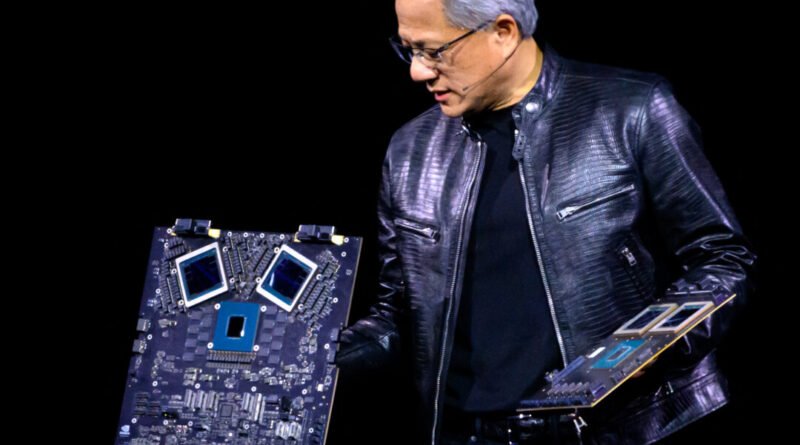The United States Tightens Semiconductor Restrictions, Leading to Heightened Technological Tensions With China.
High-tech firms in China are experiencing a decline in profits, leading to a reassessment of their market strategies.
Due to actions by the United States and other nations, China is facing challenges in accessing advanced semiconductors and the technology needed to produce them. This trend is evident even at major global artificial intelligence (AI) conferences, where discussions related to China have noticeably decreased.
The Biden administration announced revised regulations on March 29 aimed at further restricting China’s access to American AI chips and the necessary manufacturing equipment. These changes build upon previous measures to block the export of advanced AI chips, such as those produced by Nvidia, to China. Concerns in the United States center on the potential military advancements that China’s tech sector could provide to the Chinese Communist Party (CCP).
The new regulations, outlined in a 166-page document set to take effect on April 4, expand export restrictions to include laptops and other devices containing these sophisticated chips. This round of restrictions is characterized by a more stringent approach, with enforcement beginning just six days after the announcement, as opposed to the previous 30-day notice period.
Reports suggest that the United States is also set to identify key Chinese semiconductor manufacturers that will be prohibited from acquiring essential manufacturing tools, aiming to further restrict critical technology flow to China and ensure compliance with the restrictions by U.S. companies. The list of targeted facilities is expected to be released soon.
Amid increasing technological competition with the United States, Semiconductor Manufacturing International Corporation (SMIC), China’s leading chipmaker, reported a significant 60 percent drop in net profit last year. According to their annual report released on March 28, SMIC’s revenue decreased to 45.25 billion yuan ($6.26 billion), down 8.61 percent from the previous year, while net profit attributed to the parent company plummeted to 4.823 billion yuan ($670 million), a year-over-year decline of 60.25 percent.
International Allies and the Semiconductor Embargo
The United States is not only tightening restrictions on semiconductor technology but also urging allies like the Netherlands, Germany, South Korea, and Japan to participate in the technological embargo against China. These countries play critical roles in the global semiconductor supply chain, emphasizing the strategic importance of their cooperation.
During a recent visit to China on March 26-27, Dutch Prime Minister Mark Rutte engaged in discussions believed to focus on ASML, a prominent Dutch firm that supplies lithography machines for chip manufacturing worldwide. Speculation arose on whether these talks with Chinese leader Xi Jinping would impact the Dutch government’s decision regarding servicing the high-value equipment sold to China.
In 2023, the Netherlands implemented export controls limiting advanced semiconductor manufacturing equipment shipment to China. These controls also include provisions for servicing and maintenance of equipment once current licenses expire, with many set to expire by December 31 of this year.
In response to the discussions, Chinese state media did not mention the equipment issue but highlighted Xi’s affirmation of China’s legitimate right to development and determination to advance technologically despite any obstacles.
Germany’s involvement in the supply chain, particularly through Carl Zeiss AG’s provision of optical components to ASML for high-tech chip production, is under scrutiny. The United States has expressed a desire for the German firm to stop shipments of these components to China.
Last year, the German government considered restricting exports of semiconductor chemicals to China. As German Chancellor Olaf Scholz prepares for an upcoming visit to China in April, his position on this matter remains uncertain.
Similarly, the United States is encouraging Japanese companies to limit exports of specialized chip-making chemicals, including photoresist, crucial for semiconductor production to China. The upcoming Japan-U.S. summit on April 10 is expected to address these semiconductor supply chain issues further.
Global Stance on Semiconductor Export Controls
The South Korean government is deliberating aligning with the United States on imposing export controls on semiconductor equipment bound for China. Yonhap News Agency reported on March 13 that the United States has been advocating for South Korea to implement export controls since the latter half of the previous year. While a final decision from South Korea is pending, there is acknowledgment of the necessity to align with U.S. demands to a significant extent.
Taiwan, a crucial U.S. ally and semiconductor technology hub, took a significant step in December of last year by introducing the “National Core Critical Technology List.” This comprehensive list includes vital technologies across defense, space, agriculture, semiconductors, and cybersecurity.
Notably, the semiconductor segment covers advanced manufacturing processes for integrated circuits (ICs) below 14 nanometers, sophisticated heterogeneous integration packaging technologies, and necessary materials and equipment technologies.
To safeguard these technological assets, Taiwan’s Legislative Yuan amended the “National Security Law” in May of the previous year. This amendment criminalizes the transfer of national core critical technologies to foreign entities, including those from Hong Kong, Macau, and others considered hostile forces, with penalties of up to 12 years in prison.
Additionally, fines may be imposed, potentially doubled based on illicit gains from such activities. Individuals in sensitive technology sectors receiving government funding must seek authorization before traveling to mainland China.
AI expert Jason Ma, based in the United States, shared insights on April 2 with The Epoch Times, interpreting these actions as a collective effort by Western nations to strategically disentangle from the CCP in advanced technology domains.
He noted that these restrictions pose a significant setback for the CCP, increasing the costs associated with AI development. This coordinated approach reflects the broader international effort to mitigate risks linked to transferring critical technology capabilities to China, amid mounting concerns for national security and the competitive landscape in high-tech industries.

Global AI Conference Highlights Shift in Focus Away from China
The “NVIDIA GPU Technology Conference (GTC)” took place from March 18 to 21 in San Jose, California, along with an online presence. NVIDIA CEO Jensen Huang delivered a keynote speech titled “Witnessing AI’s Disruptive Moment,” underscoring the conference’s significance as a hub for the latest AI advancements. With over 900 sessions, 200 exhibitors, and 20+ technical discussions, the event was a blend of innovation and networking.
The tycoon characterized his experience at the conference as an “intellectual and magnificent spectacle” tainted by the absence of discussions on China’s AI progress or American perspectives toward China. This was evident despite the presence of numerous Chinese engineers and investors, some of whom specifically traveled from China for the conference. The blogger noted that the identity or background of Chinese participants did not attract significant attention, signaling a broader disengagement from China.
This shift is partly attributed to reduced financial reliance on the Chinese market by companies like NVIDIA, where China now accounts for only 5% of revenue, down from a previous high of 20-25%. This trend suggests that companies are reevaluating their business strategies and pivoting away from once dominant markets.
Insights shared by The Epoch Times columnist Zhou Xiaohui further elucidate this trend, indicating that the declining allure of the Chinese market is not an isolated occurrence.
These changing dynamics are influenced by fluctuating Chinese government policies and foreign company unfriendly attitudes, compounded by strict U.S. regulations. Consequently, high-tech firms are witnessing reduced profits in China, prompting a revision of market strategies and even withdrawal from the Chinese market in some cases.




